
|
Jerusalem Day and Archaeology
In the Continual War Against Israel, God and His Bible, Archaeology is Important
|
|
Sunday, June 02, 2019
|
www.bibleinthenews.com Audio & Print versions
|
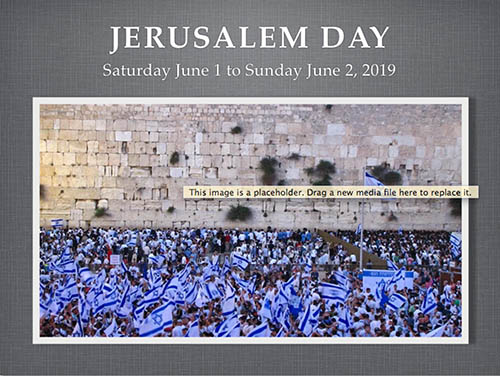
Jerusalem Day
A narrated slide show is below:
Israel, as I write, is celebrating Jerusalem Day. This year it falls on Saturday, June 1 to Sunday, June 2. It comes on the backdrop of the announcement of the second set of new elections in Israel this year. New elections could bring interesting changes to the Israeli political landscape. It is too early to see just what, but initial indications are a stronger right and religious block will emerge. As Israeli politician, Ayelet Shaked put it “There is no reason for new elections now, except that God decided to intervene.” She may just be right.

“There is no reason for new elections now,
except that God decided to intervene.” – Ayelet Shaked
Some things to watch for coming out of these elections include moves toward peace in Israel, but a peace that most of the world would say is unjust. Such a peace seems to be indicated by Ezekiel 38:14-15 and Joel 3. This may include dealing with the Palestinian problem in a frowned upon way, such as incentivized emigration or the annexation of Judea and Samaria. What we do know is that a temporary peace is established that leaves the Jews in Judea and Samaria. It is also clear that the world is displeased and their liberal “frog spirit” worldview influences them to come against Jerusalem to battle.
We live at a time when things have picked up the pace, like when Israel was marching around the walls of Jericho each day, on the last and final day they walked around 7 times. At such a time it seems that an unprecedented event like a second set of elections in one year will likely bring a notable outcome. God doesn’t seem to be wasting time bringing his purpose to pass in our day. Time will tell.
Why Jerusalem Day?
On May 14, 1948 the State of Israel was declared, without Jerusalem. Attacks that had begun by local Arabs after the UN vote the previous November broke out into a full-scale war waged by the surrounding nations who vowed to drive them into the sea. They were Egypt, Jordan, Iraq, Syria and Lebanon, who were described as a ring of steel. The world was sure that ill-equipped Israel would lose, but no one came to her defense. Trying to be even-handed, the United States enforced an arms embargo against both sides. Jerusalem was divided and the Old City + City of David fell into Arab hands. The Jews were expelled from the Arab areas and were unable to enter for almost two decades.
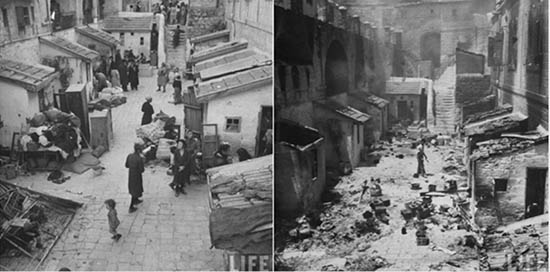
A street in the Jewish quarter before and after the ethnic cleansing of 1948.
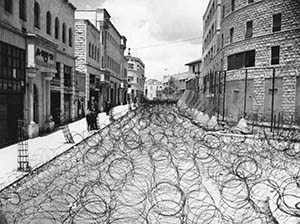
From 1948 to 1967 Jerusalem was divided...
By 1967, the Arabs had made notable progress in preparing for another try at pushing the Jews into the sea and were on the verge of invading. In June, Egypt closed the Straits of Tiran to Israeli shipping, a move considered to be an act of war. Israel responded with a surprise attack on Egyptian airfields and warplanes.
Israel asked Jordan to stay out of the war, but because they believed Egyptian propaganda stating that Egypt was winning, they decided to attack. Israel’s response led to Judea, Samaria, Jerusalem and the Benyamin region falling into Israeli hands. On June 7th Rabbi Shlomo Goren blew the shofar at the Western Wall as the paratroopers arrived.
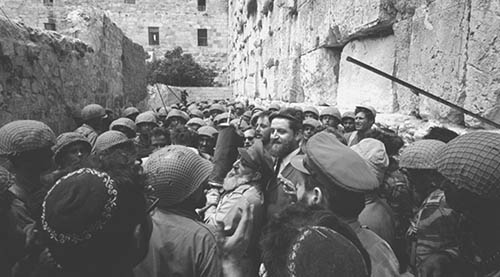
Paratroopers with Rabbi Shlomo Goren at the Western Wall of the Temple Mount, June 1967
Jerusalem Day has been kept to celebrate the reunification of the city every year since.
Archaeology
Today the conflict has many fronts. One of them is, strangely enough, archaeological. If it can be shown that the Bible is historically inaccurate, and discoveries that prove it can be hidden, it bolsters the positions of the liberal left and the Palestinians. The Palestinians claim that there never was a Jewish temple on the Temple Mount.
In 2016 UNESCO the UN agency for preserving cultural heritage and education voted for a resolution stating that UNESCO:
“5. Deeply deplores the failure of Israel, the occupying Power, to cease the persistent excavations and works in East Jerusalem particularly in and around the Old City, and reiterates its request to Israel, the occupying Power, to prohibit all such works in conformity with its obligations under the provisions of the relevant UNESCO conventions, resolutions and decisions;”
Exactly how forbidding archaeological digs preserves cultural heritage, is difficult to understand. What it does do is to try and keep the facts as concealed as possible. Clearly, someone is worried about what else might be found.
The resolution was widely seen as a denial of the Jewish connection to the Temple Mount and Western Wall.
A recent book by quite an unbelieving Jewish archaeologist, Israel Finkelstein, makes some remarkable admissions. Among them are the following
“...archaeological surveys, settlement studies and extra-biblical records converge with Biblical traditions at numerous points.”
“extensive administrative details in Deuteronomy or Joshua - 2 Kings “unnecessary” if the Bible is just mythic history.”
He also “boldly claims that archaeology is the only real-time witness to events described in the biblical text, particularly those relating to the formative phases of early Israelite history.”
There are, of course, other witnesses such as Prophecy, but still a remarkable quote to come from a secular source.
House of David Inscription
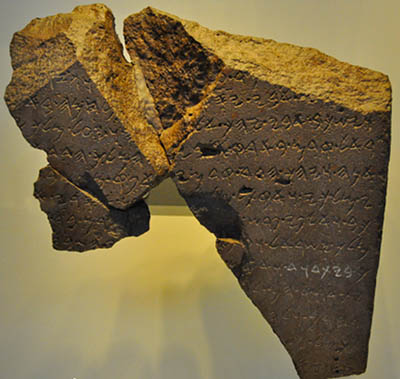
House of David Inscription, Tel Dan
After the house of David Inscription was discovered, there was no longer a debate about if there was a King David, rather how great of a power was his Kingdom? It provided empirical evidence of one of the most prominent Bible characters who was mentioned almost a thousand times in the Bible.
The Stele was written by Hazael king of Syria. It reads as follows:
1. [ ]...[...] and cut [...]
2. [...] my father went up [against him when h]e fought at [...]
3. and my father lay down, he went to his [ancestors (viz. became sick and died)]. And the king of I[s-]
4. rael entered previously in my father's land, [and] Hadad made me king,
5. And Hadad went in front of me, [and] I departed from the seven [...-]
6. s of my kingdom, and I slew [seve]nty kin[gs], who harnessed th[ousands of cha-]
7. riots and thousands of horsemen (or: horses). [I killed Jeho]ram son [of Ahab]
8. king of Israel, and [I] killed [Ahaz]iahu son of [Jehoram kin-]
9. g of the House of David, and I set [their towns into ruins and turned ]
10. their land into [desolation ]
11. other [... and Jehu ru-]
12. led over Is[rael and I laid]
13. siege upon [ ]
When we compare this to the Bible, we see that it provides not only evidence of the existence of King David and his dynasty, but also verifies the truth of a Bible prophecy of the time.
2 Kings 8:10-12 “10 And Elisha said unto him, Go, say unto him, Thou mayest certainly recover: howbeit the LORD hath shewed me that he shall surely die. 11 And he settled his countenance stedfastly, until he was ashamed: and the man of God wept. 12 And Hazael said, Why weepeth my lord? And he answered, Because I know the evil that thou wilt do unto the children of Israel: their strong holds wilt thou set on fire, and their young men wilt thou slay with the sword, and wilt dash their children, and rip up their women with child.”
City of David excavations
The Ascent to the temple
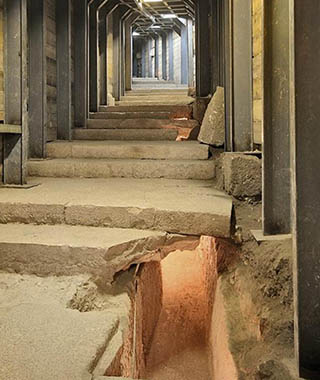
The Ascent to the Temple
A recent exciting discovery is the ascent up to the temple from the pool of Siloam. Worshippers could cleanse themselves in the pool and then make the final climb to the house of God. Jesus would have walked this road many times. Interesting things have been found as they excavated the road and the drainage channel below.
“Now about the midst of the feast Jesus went up into the temple, and taught.” John 7:14
The Golden Bell
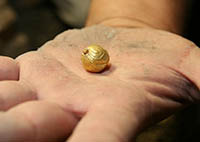
Golden Bell
This small golden bell was found in the drainage channel under the ascent to the Temple that we just mentioned. It seems highly likely that this is one of the bells from the High Priest’s garment mentioned in Exodus:
Exodus 28:33, 34 “33 And beneath upon the hem of it thou shalt make pomegranates of blue, and of purple, and of scarlet, round about the hem thereof; and bells of gold between them round about: 34 A golden bell and a pomegranate, a golden bell and a pomegranate, upon the hem of the robe round about.”
The Beka
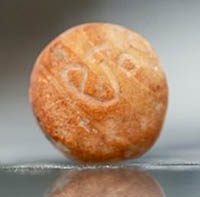
The Beka Weight
There was a small marble size stone found with an ancient Hebrew inscription on it. It reads Beka. Some time passed before they realized that it was mentioned in the Bible:
Exodus 38:25, 26 “And the silver of them that were numbered of the congregation was an hundred talents, and a thousand seven hundred and threescore and fifteen shekels, after the shekel of the sanctuary: A bekah for every man, that is, half a shekel, after the shekel of the sanctuary, for every one that went to be numbered, from twenty years old and upward, for six hundred thousand and three thousand and five hundred and fifty men.”
A second discovery confirmed that they were correct.
The half shekel silver coin - Holy Jerusalem
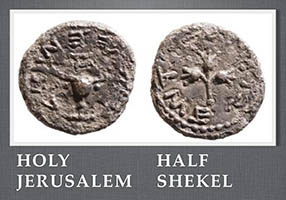
A half shekel silver coin was found during the same excavations. On one side it says Half Shekel and on the other, it says Holy Jerusalem. The coin and the Beka weigh the same, confirming that the Beka is the weight mentioned in Exodus. This serves as solid evidence that Hebrew speakers lived here, they considered Jerusalem to the holy, and were following Jewish, Biblical practices.
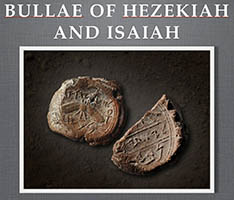
Bullae of Hezekiah and Isaiah
These were the signatures of the day. Hezekiah and Isaiah are mentioned together in the same verse of the Bible 16 times. Their Bullae were found within three meters or about 3 yards of each other. This verifies that these men lived when the Bible said they did, where the Bible said they were. Once again showing Jewish presence in Judea, or more specifically in Jerusalem, in the City of David, or Silwan as the Arabs call it. Silwan is believed to be from the Hebrew word Siloam, the name of the pool in the area.
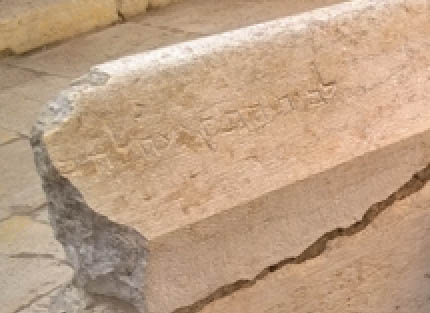
The place of Trumpeting
Place of Trumpeting Inscription
This stone, although thrown down by the Romans, previously marked the place of trumpeting which was where the Sabbath was announced. The blasts are detailed in the Talmud (Shabbat 35b). It would also be where the various trumpet calls mentioned in the Law would be made. The inscription can be read by modern Hebrew speakers today, who would understand its significance.
This is evidence of the Biblical record and that what we are witnessing is the restoration of the Jewish people, language and customs in Jerusalem. They were there before and are coming home.
Numbers 10:2-4 “2 Make thee two trumpets of silver; of a whole piece shalt thou make them: that thou mayest use them for the calling of the assembly, and for the journeying of the camps. 3 And when they shall blow with them, all the assembly shall assemble themselves to thee at the door of the tabernacle of the congregation. 4 And if they blow but with one trumpet, then the princes, which are heads of the thousands of Israel, shall gather themselves unto thee.”
The Ketef Hinnom Scrolls/Amulets (KH1 & KH2)
These small silver scrolls, "about the size of a cigarette butt", were discovered in a burial cave between Jerusalem and Bethlehem. They are engraved with Biblical text. The KH2 contains the priestly blessing of Numbers 6:24-26. The other, KH1 contains the following:
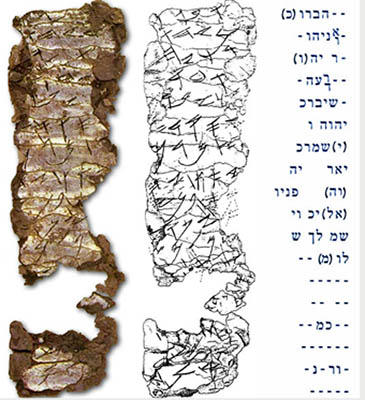
The Ketef Hinnom Scroll/Amulet KH1
[Top line(s) broken]
...] YHW ...
[...]
the grea[t ... who keeps]
the covenant and
[G]raciousness towards those who love [him] and (alt: [hi]m;)
those who keep [his commandments ...
...].
the Eternal? [...].
[the?] blessing more than any
[sna]re and more than Evil.
For redemption is in him.
For YHWH
is our restorer [and]
rock. May YHWH bles[s]
you and
[may he] keep you.
[May] YHWH make
[his face] shine ...
[Bottom line(s) broken.]
KH1 is a prophecy coming true today, the time in which it was discovered. God is keeping his covenant, he is restoring and redeeming his people. UNESCO and any others that would like to, cannot stop the restoration or redemption of Israel. They can bury their heads in the sand, but the purpose of God will march on to completion.
Please join us again next week for more Bible in the News, God willing.
Tim Billington